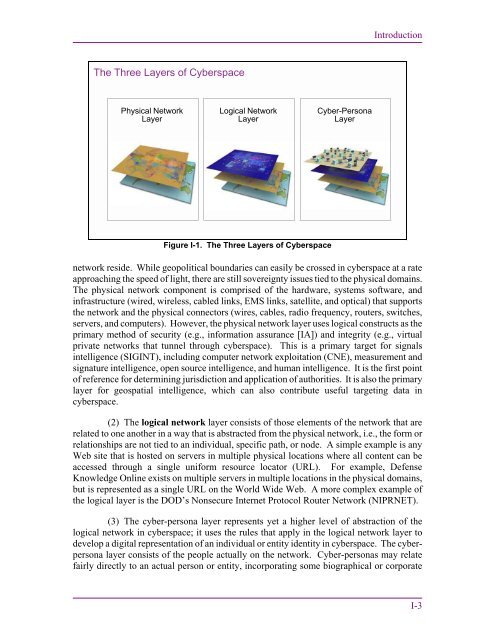jp3_12r
jp3_12r
jp3_12r
Create successful ePaper yourself
Turn your PDF publications into a flip-book with our unique Google optimized e-Paper software.
Introduction<br />
The Three Layers of Cyberspace<br />
Physical Network<br />
Layer<br />
Logical Network<br />
Layer<br />
Cyber-Persona<br />
Layer<br />
Figure I-1. The Three Layers of Cyberspace<br />
network reside. While geopolitical boundaries can easily be crossed in cyberspace at a rate<br />
approaching the speed of light, there are still sovereignty issues tied to the physical domains.<br />
The physical network component is comprised of the hardware, systems software, and<br />
infrastructure (wired, wireless, cabled links, EMS links, satellite, and optical) that supports<br />
the network and the physical connectors (wires, cables, radio frequency, routers, switches,<br />
servers, and computers). However, the physical network layer uses logical constructs as the<br />
primary method of security (e.g., information assurance [IA]) and integrity (e.g., virtual<br />
private networks that tunnel through cyberspace). This is a primary target for signals<br />
intelligence (SIGINT), including computer network exploitation (CNE), measurement and<br />
signature intelligence, open source intelligence, and human intelligence. It is the first point<br />
of reference for determining jurisdiction and application of authorities. It is also the primary<br />
layer for geospatial intelligence, which can also contribute useful targeting data in<br />
cyberspace.<br />
(2) The logical network layer consists of those elements of the network that are<br />
related to one another in a way that is abstracted from the physical network, i.e., the form or<br />
relationships are not tied to an individual, specific path, or node. A simple example is any<br />
Web site that is hosted on servers in multiple physical locations where all content can be<br />
accessed through a single uniform resource locator (URL). For example, Defense<br />
Knowledge Online exists on multiple servers in multiple locations in the physical domains,<br />
but is represented as a single URL on the World Wide Web. A more complex example of<br />
the logical layer is the DOD’s Nonsecure Internet Protocol Router Network (NIPRNET).<br />
(3) The cyber-persona layer represents yet a higher level of abstraction of the<br />
logical network in cyberspace; it uses the rules that apply in the logical network layer to<br />
develop a digital representation of an individual or entity identity in cyberspace. The cyberpersona<br />
layer consists of the people actually on the network. Cyber-personas may relate<br />
fairly directly to an actual person or entity, incorporating some biographical or corporate<br />
I-3


